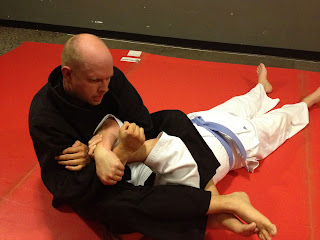Peel the Arm
Juji Gatame – more correctly called Ude Hishigi Juji Gatame - the straight
arm lock (or armbar) is one of the most widely used techniques in the grappling
arts. It is called the most powerful arm lock in Judo. Rarely does an MMA event
take place where a juji gatame is not used. It is widely seen in Brazilian
Jiu-Jitsu (BJJ) and SAMBO tournaments.
Due to the nature of juji gatame, it is only wise for the grappling student
to study ways to defeat or otherwise escape juji gatame. In response, the
grappler who wishes to secure juji gatame must develop a game plan to defeat the
inevitable escape attempts. In the following sequence, we will demonstrate a
method of securing juji gatame that has been used numerous times by UFC women’s
bantamweight champion, Ronda Rousey, in MMA competition. This same method is
standard practice at my studio - the Usagi Dojo in Mt. Juliet, TN.
This photo demonstrates two things: A) how very ugly I am. B) A standard attempt at juji gatame. There are
numerous ways to get to this position, ask your instructor for some of her
favorite methods!
In the next photo, my opponent, Richard, has crossed his arms in a hadaka-jime type manner as a
defense. This is a common tactic to buy some time. I have moved my leg off of
Richard’s face so details of the defense can be seen. In practicality, one would
never drop the leg off the face like this, unless one wanted to give up on the juji gatame attempt.
So how does one counter this defense? Simple... the “spider web!”
Step one
of the spider web is to lock the crook of your elbow to the crook of your
opponent’s elbow.
In Judo and BJJ competitions, one may grab one’s own
lapel (photo 4) to strengthen the grip.
Second step is to grab the far arm behind the elbow and tug it toward you. Sometimes, this will break the defensive grip, sometimes it won’t
break the grip. When the arm is near you, cross your feet behind the far
shoulder.
Step three is to peel the arm out and finish. This step is simple, but
there are two major ways it can be done – to the “north” (toward the opponent’s
head at 45-degrees), and “south” (toward the opponent’s feet at 45-degrees).
Which direction you go depends directly on what angle the opponent’s wrist is
facing.
That’s right – the wrist. A common mistake is to tug firmly against the
elbow. This is a fantastic way to waste energy Instead, keeping with the
principle of “maximum efficiency, minimum effort" is to get the wrist to flex.
To accomplish wrist flexion, it is necessary to follow these steps:
A) I determine which direction Richard’s wrist is facing. If necessary, I will change the hooking arm.
B) For the “north” break, I place my north arm (right arm in the photo)
in a wrist-to-wrist position.
For a “south” break, place the south wrist (my
left arm in photo 8) against the opponent’s wrist.
C) Lean with the effort of the entire body until the arm is peeled free,
then go back to center (90-degrees from the opponent) like in this photo. Since the
entire body is used, a very small, weak person can easily peel the arm of a
large, powerful man.
Finish juji gatame as shown in the final photo. Remember – slowly apply pressure
in training. Be mindful of the opponent’s thumb positioning. Also, keep pressure
on the opponent’s body and head by pressing with the sides of the knees in a
“butterfly” type motion. The crossed feet should be tugging the opposite
shoulder toward you.
Without a doubt, there are many finishes for juji gatame. Most of them
require the proper circumstance and setup to be effective. The best benefit of
using the method shown is that it is useful against many types of defenses, as
well as being useful in gi and no-gi situations.
Special thanks also to my student, Sarah, who was the photographer. Sarah has used juji
gatame to win more than half of her competitive grappling matches.
.












Comments
Post a Comment
Your comment will be displayed after approval.
Approval depends on what you say and how you say it.